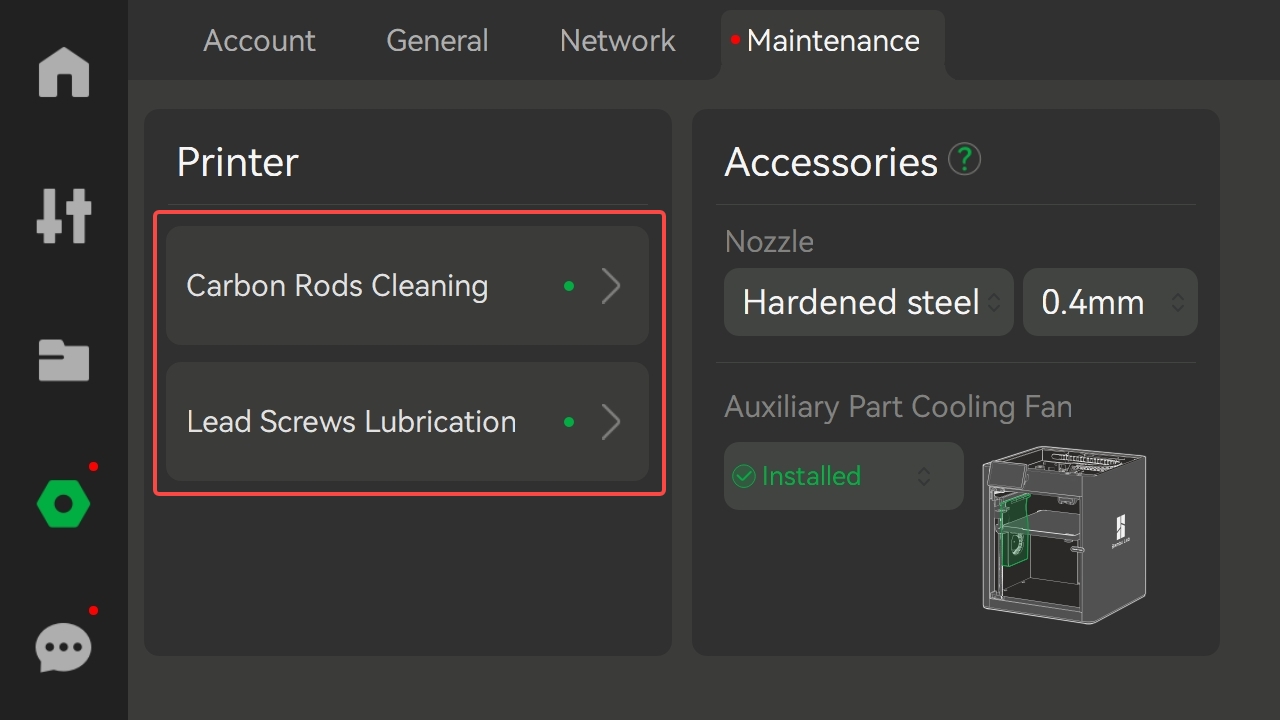¶ Introduction
This guide is intended to introduce the X1 series printer screen buttons and operating functions.
¶ Homepage
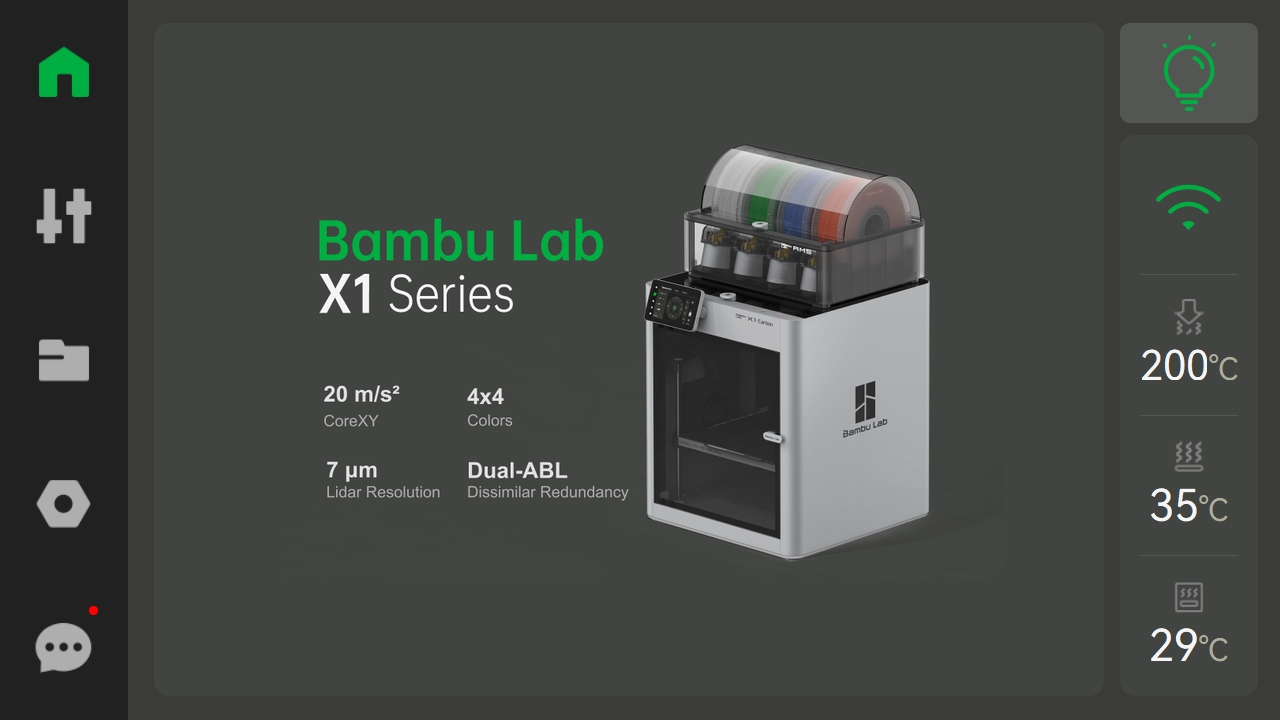
On the left side of the homepage is an on-screen menu bar that includes Homepage, Controls, Folders, Settings, and HMS Messages; on the right side is the LED infill light, Network Settings, Nozzle Temperature, Heatbed Temperature, and Chamber Temperature.
¶ Controls
Controls menu includes:Temperature/Axis、Filament、Utilities and Print Options.
¶ Temperature/Axis
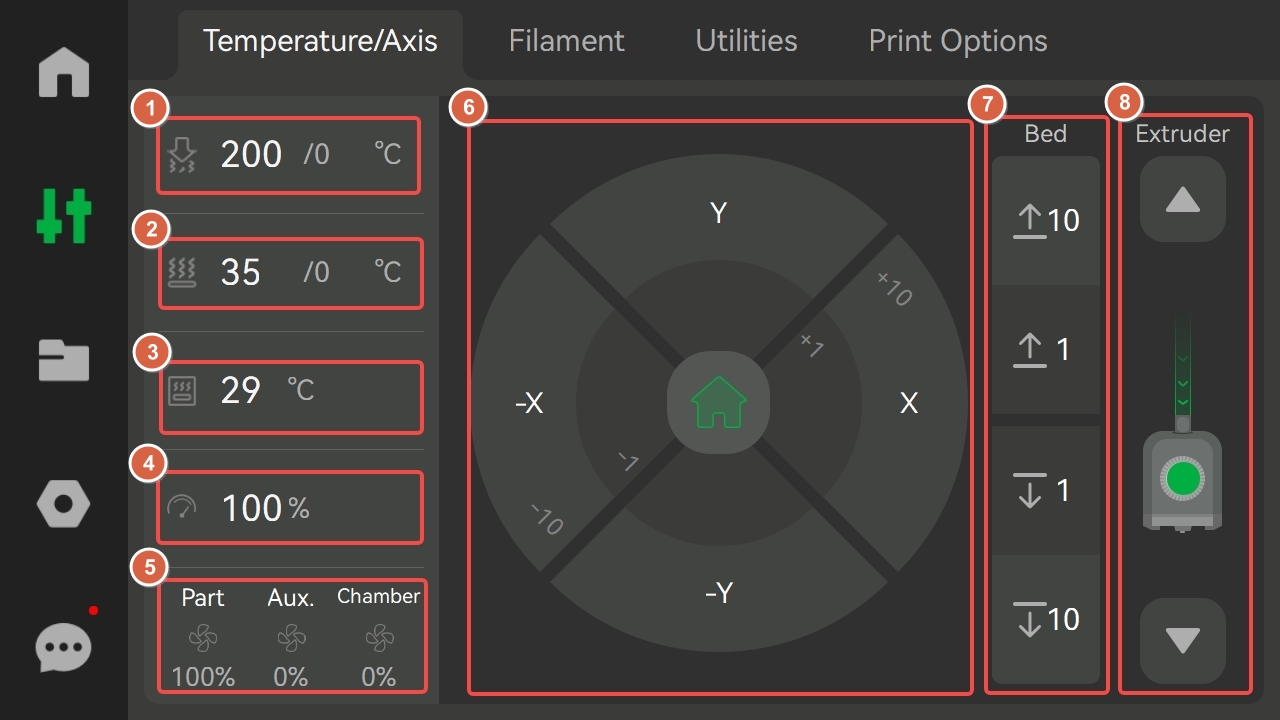
-
Nozzle Temperature:Enter a value to set the nozzle temperature.
-
Heatbed Temperature:Enter a value to set the heatbed temperature.
-
Chamber Temperature:Display the chamber temperature. (X1E can set the chamber temperature actively, please refer to: X1E Chamber Setting Guide)
-
Printing Speed:Set the printing speed mode.

- Ludicrous:166% of normal print speed and acceleration
- Sport:124% of normal print speed and acceleration
- Standard:normal print speed and acceleration
- Silent:50% of normal print speed and acceleration
Please note that changing the print speed from the screen only increases the print speed and does not adjust the hotend temperatures to compensate. It is recommended to use lower layer heights when using higher print speeds adjusted from the screen, and to correctly adjust the print settings in order to avoid print failures.
- Fan Settings: Turn on or off the part cooling fan, auxiliary part cooling fan and chamber temperature regulator fan, and set the speed.

| Part cooling fan | Auxiliary part cooling fan | Chamber temperature regulator fan |
|---|---|---|
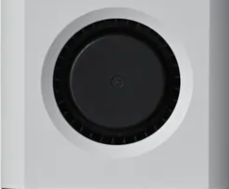 |
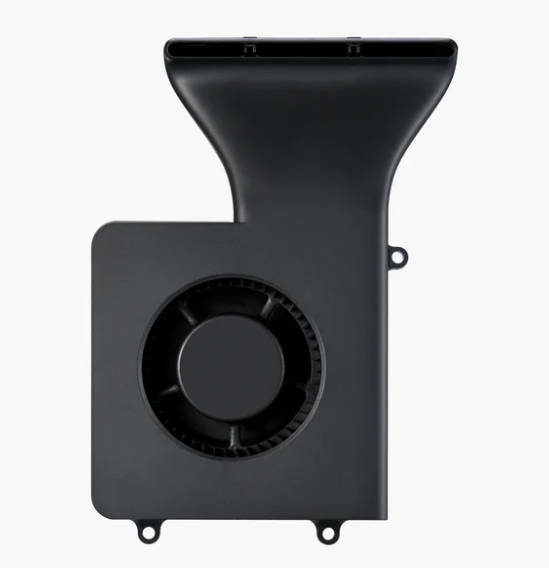 |
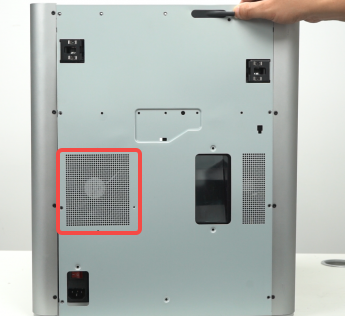 |
-
XY-axis control dial: Click +1 or +10 to control the toolhead movement in the X-axis and Y-axis.
-
Print Plate Lift Control: Click the 1-frame or 10-frame move button to raise or lower the heatbed.
-
Extruder: Click the up and down buttons to manually extrude or eject 1 cm of filament. If the green light is on, the extruder filament sensor has detected the entry of filament.
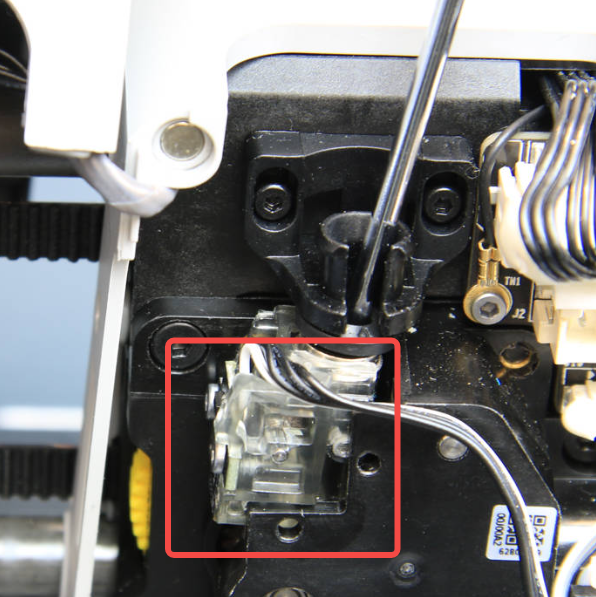
¶ Filament

-
Spool Holder:If an spool holder is used, you can configure the filament color and type here. This information will always be displayed whether or not the spool holder have filaments.
-
Spool:Each of these spools corresponds to one of the four spools in the AMS. When the printer is connected to four AMS, the filament color symbols for each AMS will be displayed at the top, and you can select and operate a specific AMS by clicking on the corresponding symbol.
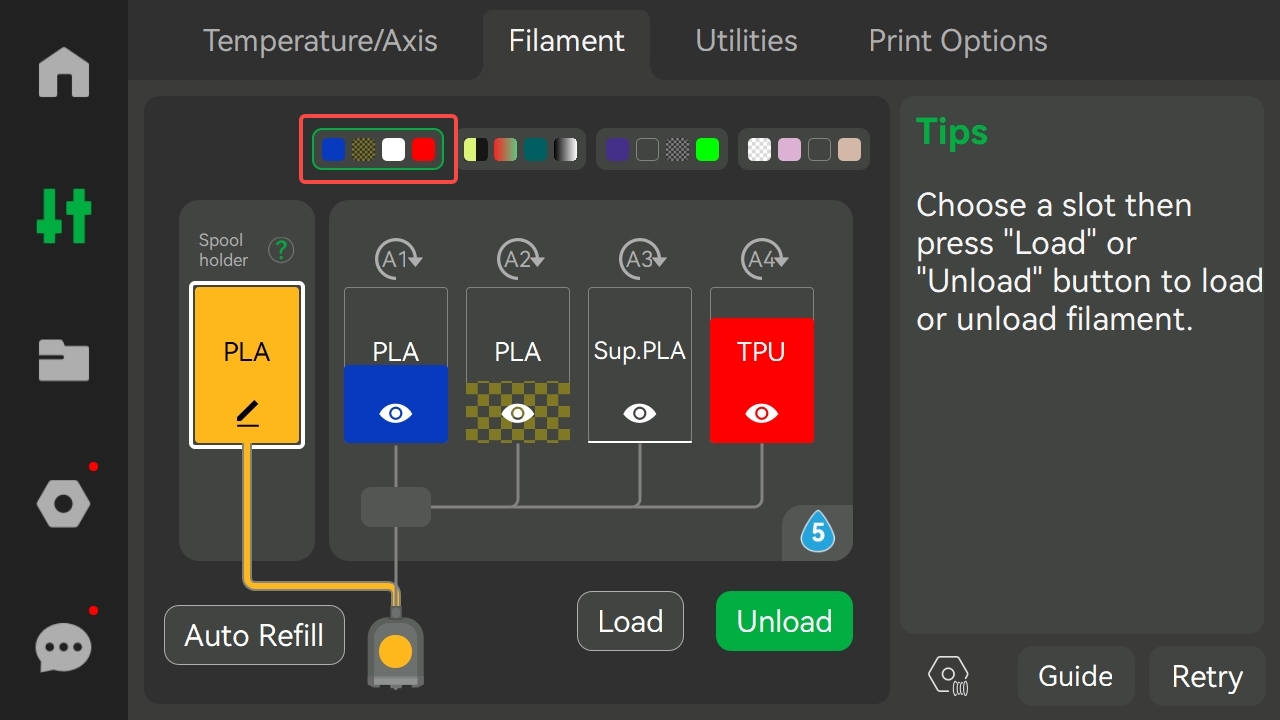
-
Auto Refill: AMS will continue to another spool with the same properties of filament automatically when current filament runsout. Make sure that there are supplies in the spool with the same properties and that the corresponding spool information on AMS is the same. Please enable this feature in AMS Settings.
-
Load and Unload:Select a spool and click the Load or Unload button to perform the corresponding operation.
-
Currently performing task:A cursor indication shows whether an operation step for loading or unloading has been completed or not.
-
AMS Settings:
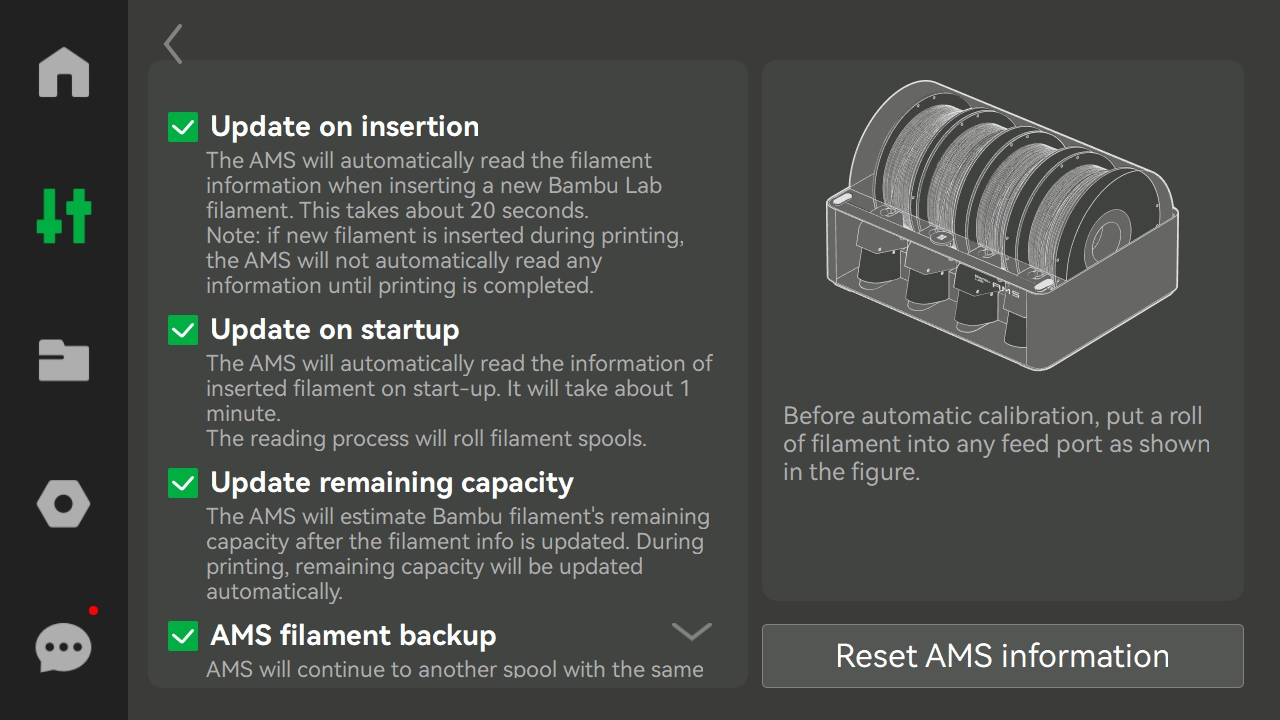
-
Update on insertion: The AMS will automatically read the filament information when inserting a new Bambu Lab filament.
-
Update on startup:The AMS will automatically read the information of inserted filament on start-up.
-
Update remaining capacity:Remainder estimation of filaments while RFID is being read. When this feature is turned on, the RFID will perform two readings, one for filaments information and one for residual quantity estimation. Please refer to this wiki for more information.
-
AMS filament backup:AMS will continue to another spool with the same properties of filament automatically when current filament runsout. Please refer to this wiki for more information.
-
Guide:Introduce the loading line, spool status indication and AMS control interface.
-
Retry:If a process fails, you can click this button to retry.
¶ Utilities

- Device self-test:If the printer encounters a malfunction, the problem can be detected by the device self-test.

- Calibrate:Printer calibration through bed leveling, motor noise calibration, micro lidar calibration and resonance frequency identification.

-
Bed leveling:Adjust the distance between the nozzle and the print plate to ensure that the gap is consistent at each corner and to improve printing accuracy.
-
Motor noise calibration:Reduces motor noise during printing, especially when printing for long periods of time or at high speeds, and makes the print surface smoother.
-
Micro lidar calibration:Adjust the position of the laser and camera to ensure clear and accurate images of the laser line at different positions.
-
Resonance frequency identification:Vibration testing at different frequencies identifies the response of the printer, which reduces vibration and improves print stability.
- Dry Filament:Set the drying temperature and time duration to dry the filament. Please refer to this wiki for more information.
¶ Print Options

-
Enable Al monitoring of printing:Detect spaghetti and filament buildup in excess chute during printing.
-
Enable detection of build plate position:Detects print plate markings. If the markings are not within the predefined range or do not match the slice file, the printer stops printing. This prevents unplaced or misplaced print plates.
-
First Layer Inspection:Once the first layer has been printed, the system automatically detects the print quality and warns you if an abnormality is detected.
-
Auto-recovery from step loss:When the motor detects a position shift (lost step), the X-axis, Y-axis, and Z-axis are repositioned and returned to the pre-shift position to continue executing the unfinished G-code to ensure print quality.
-
Cache cloud print files to MicroSD card:This option is turned on by default. For prints initiated through the cloud, the print file is cached to a folder in the root directory of the SD card.
Please refer to this wiki for more information on print options.
¶ Folders
Folders menu includes: Internal、MicroSD Card and Print Cache.
¶ Internal
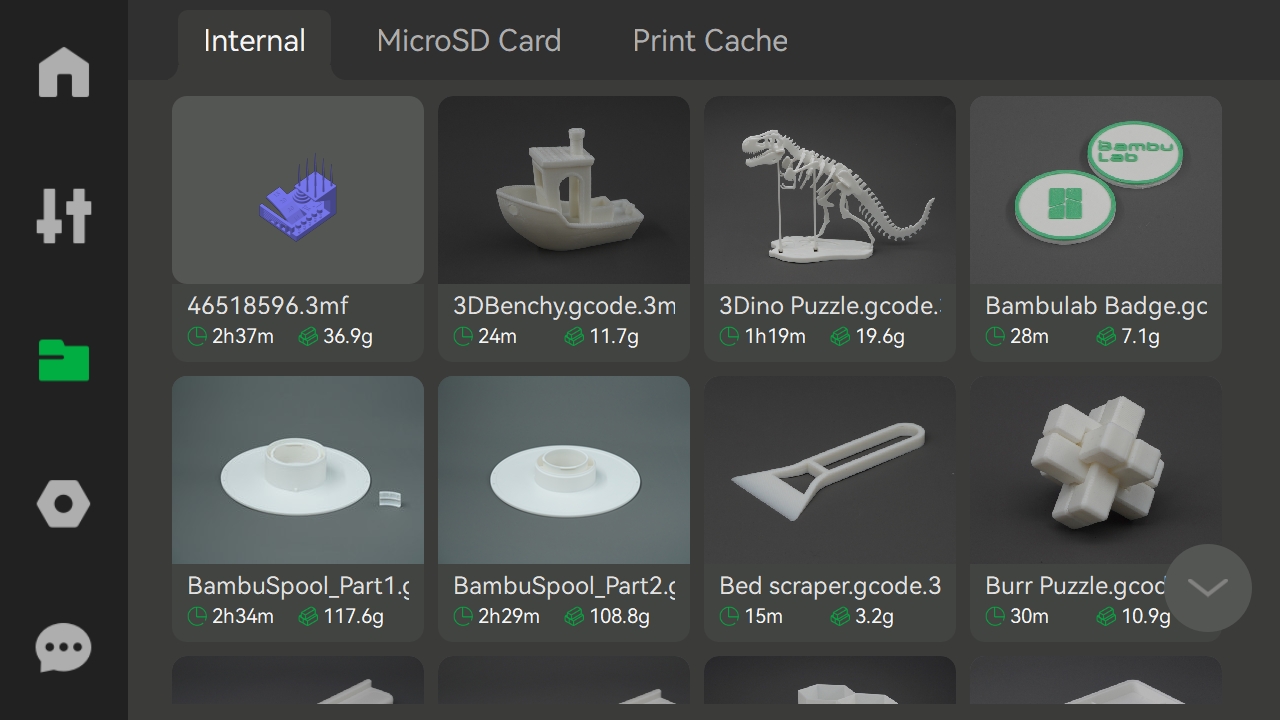
Save the printer's pre-stored model files and the most recent printout.
¶ MicroSD Card
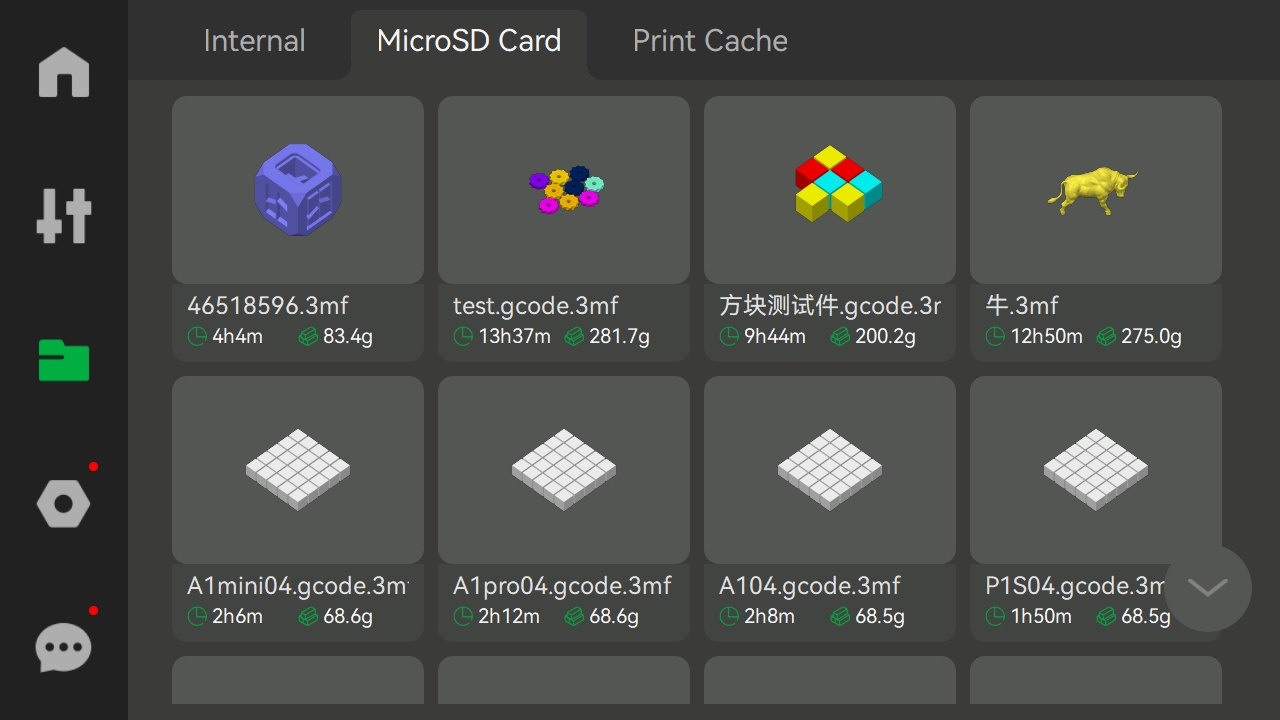
Store and manage model files and other data on the printer's SD card.
¶ Print Cache
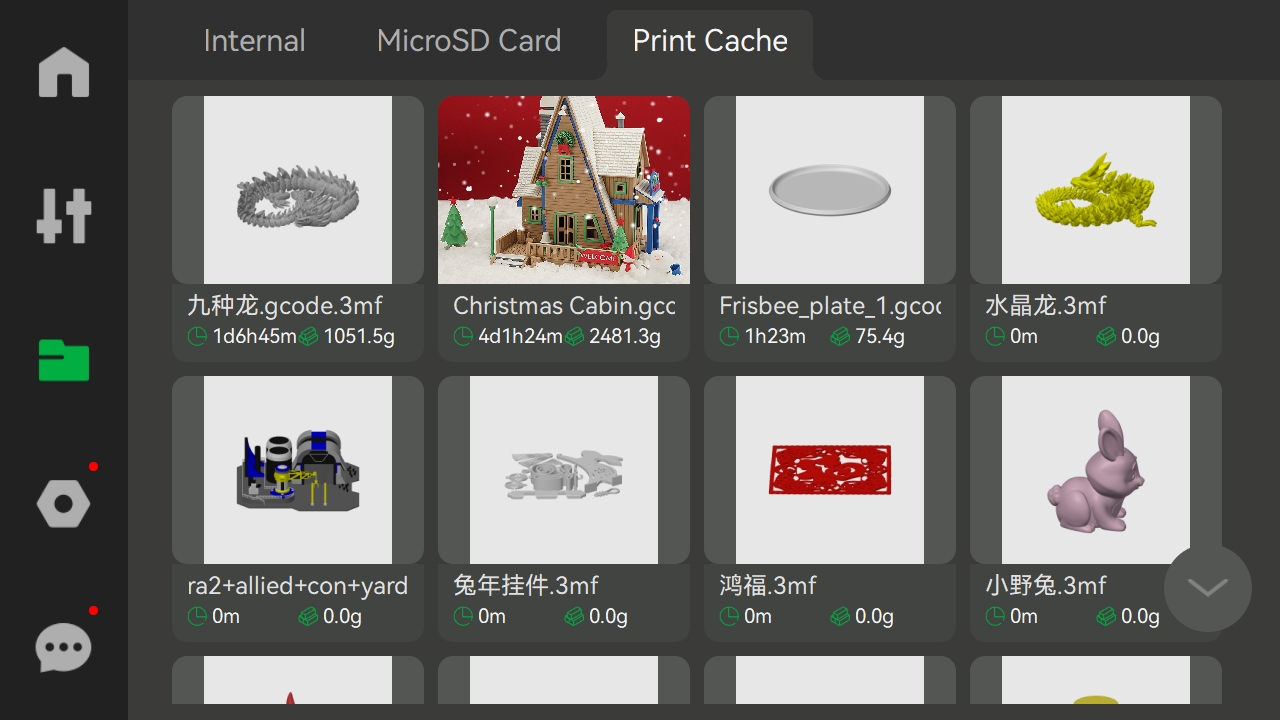
This feature is enabled by default in Print Options. If you select this option when printing through cloud, the 3mf will be stored in the cache folder of the MicroSD Card root directory.
Note: The print cache can store up to “8” 3mf files. If it exceeds, the oldest 3mf file cached will be deleted. When the remaining capacity of the MicroSD Card is less than 500MB, some old print cache 3mf files may be deleted to ensure that the current print 3mf file can be cached. If deleting all the old 3mf files still does not meet the capacity requirements, current print 3mf file will not be cached into the MicroSD Card, and an HMS prompt message will be reported at this time.
¶ Settings
Settings menu includes: Account、General、Network and Maintenance.
¶ Account

Open Bambu Handy and scan the code to access the account.
¶ General
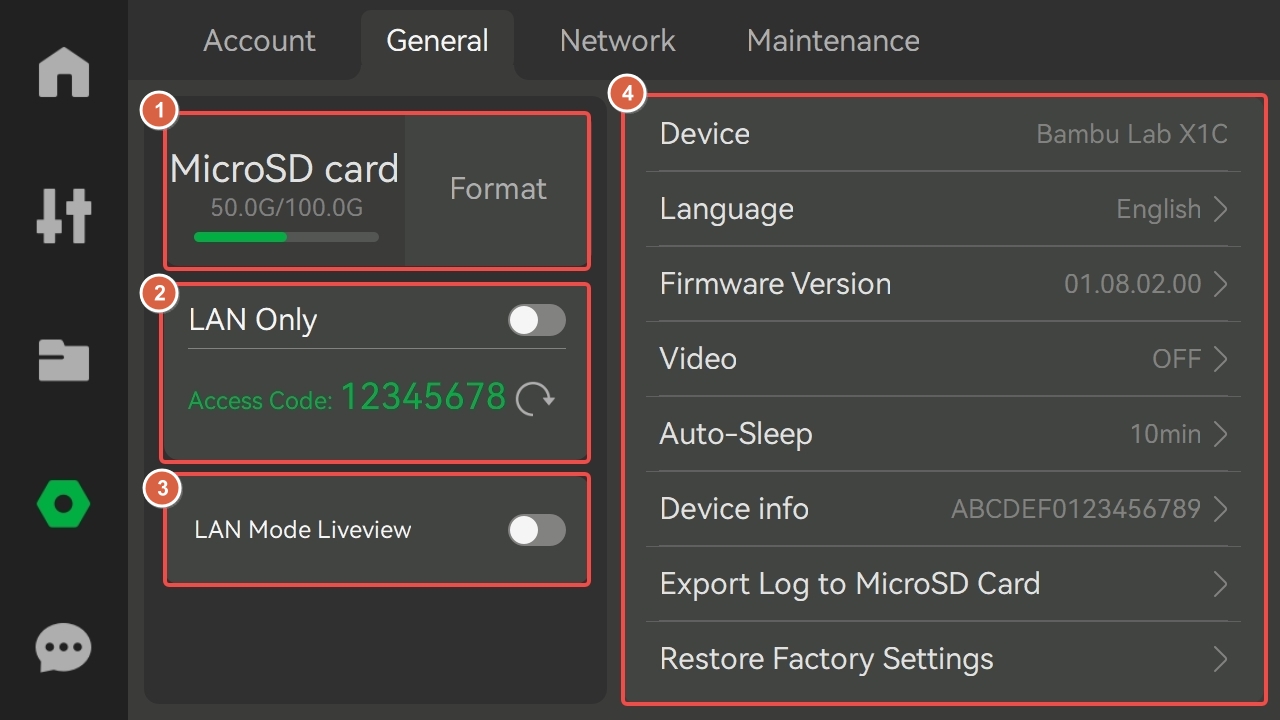
-
MicroSD Card: View the capacity of the printer's SD card and format the settings.
-
LAN only:When turned on, the printer can only be connected and accessed within the local network and cannot be accessed or controlled remotely over the Internet. Please refer to this wiki for more information.
-
LAN Mode Liveview:If multiple devices are connected via the same LAN, liveview or data sharing is possible.
-
Setting menu:
-
Device: View the printer device name.
-
Language: Select the language in which the printer screen is displayed.
-
Firmware Version: View the current version of the device.
-
Video: Set the video resolution. Higher resolution requires more storage space.
-
Auto-sleep: Select the length of time the printer will automatically sleep.
-
Device Info: View the serial number of the printer and AMS and the length of time the device has been in use.
-
Export Log to MicroSD Card:Export all Logs, key photos from camera and G-code.
-
Restore Factory Settings:Reset the printer to the factory settings. Once reset, the settings cannot be restored.
¶ Network

Set up the WLAN, view the current network, test network, or view and add other networks. Please refer to this wiki for more information.
¶ Maintenance
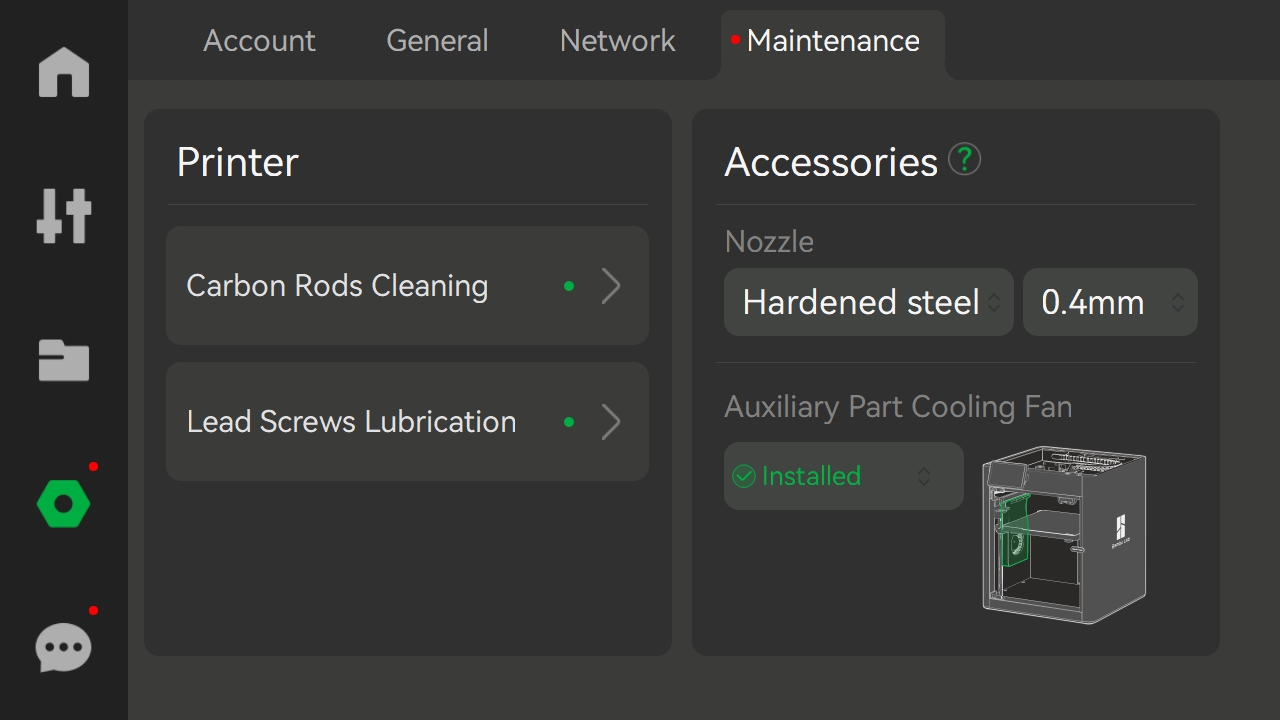
- Printer:View the operating instructions related to Carbon Rods Cleaning and Lead Screws Lubrication.
Note: If the need for maintenance is detected, the maintenance item will be prompted with a small green dot.
- Accessories:If the accessories have been replaced, reset the nozzle and auxiliary part cooling fan to ensure print quality.
¶ HMS Messages
HMS message menu includes:Controller、Filament、Toolhead、Micro Lidar and AP.
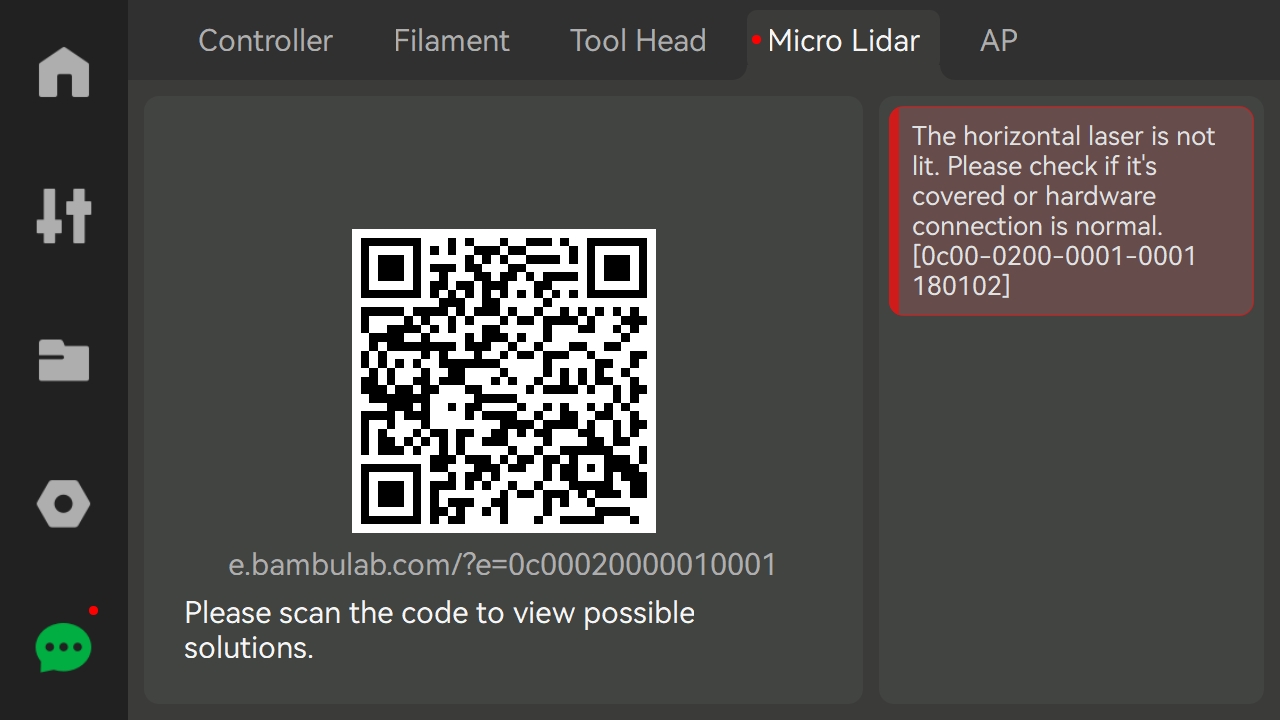
When there is a malfunction in the printer, you can use the Bambu Handy app to scan the QR code to see the solution to that fault.
For more information on HMS, please refer to HMS home page.
¶ End notes
We hope the detailed guide provided has been helpful and informative.
To ensure a safe and effective execution, if you have any concerns or questions about the process described in this article, we recommend submitting a technical ticket regarding your issue. Please include a picture or video illustrating the problem, as well as any additional information related to your inquiry.
